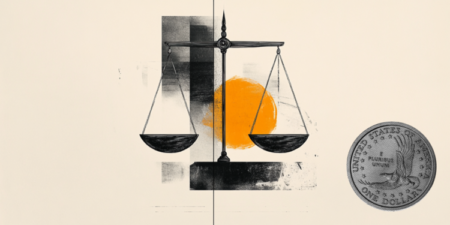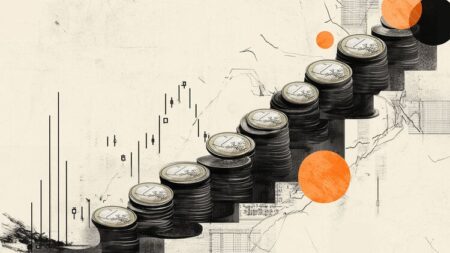- Indian Rupee extends the decline in Wednesday’s Asian session.
- A fall in local equities and ongoing US Dollar demand weigh on the INR.
- Traders brace for the Fed’s Barkin speech later on Wednesday.
The Indian Rupee (INR) edges lower on Wednesday. The US Dollar (USD) bids from foreign banks, likely on behalf of custodial clients, and the weaker Chinese Yuan weigh on the Indian currency. Additionally, a decline in local equities and a rise in crude oil prices also undermine the INR.
Nonetheless, a multi-phase trade deal between the US and India might help limit the local currency’s losses. According to Bloomberg, India is discussing a US trade deal structured in three tranches and expects to reach an interim agreement before July, when US President Donald Trump’s reciprocal tariffs are set to kick in.
Traders will monitor the speech from the Federal Reserve’s (Fed) Thomas I. Barkin later on Wednesday. On Thursday, the preliminary reading of India’s Purchasing Managers Index (PMI) for May will be released.
Indian Rupee softens as corporate seasonal demand for US Dollar remains high
- “The Indian rupee opened a tad weaker and will remain in a range of 85.25/75 for the day as there is no fresh market indicator for it to change course,” said Anil Kumar Bhansali, Head of Treasury and Executive Director, Finrex Treasury Advisors LLP.
- Atlanta Fed President Raphael Bostic said on Tuesday that it would take time for the Fed to fully understand the economic effects of Trump’s new tariff policy. Because of that prolonged process, he only saw room for one interest rate cut this year.
- St. Louis Fed President Alberto Musalem stated that current policy remains appropriate if trade tensions are durably de-escalated.
- Cleveland Fed President Beth Hammack noted that tremendous uncertainty weighs on economic activity. Hammack sees rising odds of a stagflation scenario, where low growth is coupled with high inflation.
USD/INR maintains a bearish tone under the 100-day EMA
The Indian Rupee weakens on the day. The USD/INR pair keeps the bearish vibe on the daily timeframe, with the price holding below the key 100-day Exponential Moving Average (EMA). Further consolidation or temporary recovery cannot be ruled out as the 14-day Relative Strength Index (RSI) hovers around the midline, suggesting neutral momentum in the near term.
The initial support level for USD/INR is seen at 85.34, the low of May 19. Sustained bearish pressure that could extend the drop to 85.00, the psychological level, followed by 84.61, the low of May 12.
On the flip side, the first upside barrier is located ata the 100-day EMA at 85.60. Green candlesticks busting above the mentioned level could potentially lift the pair back up to the next resistance at the 85.90-86.00 zone, which marks both the upper boundary of the trend channel and a round figure.
Indian Rupee FAQs
The Indian Rupee (INR) is one of the most sensitive currencies to external factors. The price of Crude Oil (the country is highly dependent on imported Oil), the value of the US Dollar – most trade is conducted in USD – and the level of foreign investment, are all influential. Direct intervention by the Reserve Bank of India (RBI) in FX markets to keep the exchange rate stable, as well as the level of interest rates set by the RBI, are further major influencing factors on the Rupee.
The Reserve Bank of India (RBI) actively intervenes in forex markets to maintain a stable exchange rate, to help facilitate trade. In addition, the RBI tries to maintain the inflation rate at its 4% target by adjusting interest rates. Higher interest rates usually strengthen the Rupee. This is due to the role of the ‘carry trade’ in which investors borrow in countries with lower interest rates so as to place their money in countries’ offering relatively higher interest rates and profit from the difference.
Macroeconomic factors that influence the value of the Rupee include inflation, interest rates, the economic growth rate (GDP), the balance of trade, and inflows from foreign investment. A higher growth rate can lead to more overseas investment, pushing up demand for the Rupee. A less negative balance of trade will eventually lead to a stronger Rupee. Higher interest rates, especially real rates (interest rates less inflation) are also positive for the Rupee. A risk-on environment can lead to greater inflows of Foreign Direct and Indirect Investment (FDI and FII), which also benefit the Rupee.
Higher inflation, particularly, if it is comparatively higher than India’s peers, is generally negative for the currency as it reflects devaluation through oversupply. Inflation also increases the cost of exports, leading to more Rupees being sold to purchase foreign imports, which is Rupee-negative. At the same time, higher inflation usually leads to the Reserve Bank of India (RBI) raising interest rates and this can be positive for the Rupee, due to increased demand from international investors. The opposite effect is true of lower inflation.
Read the full article here
















